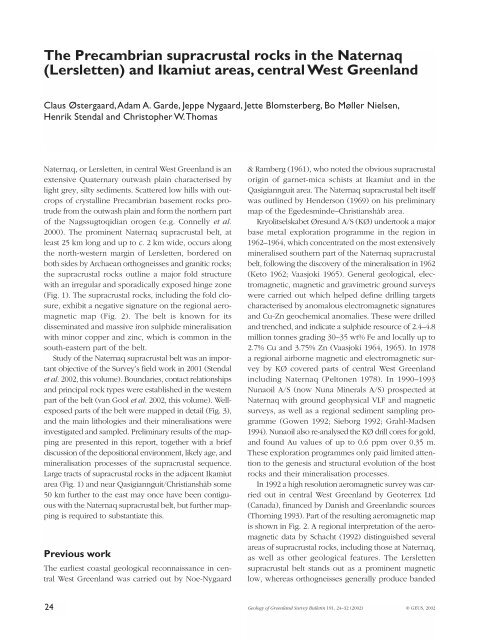Review of Greenland Avtivities 2001 - Geus
Review of Greenland Avtivities 2001 - Geus
Review of Greenland Avtivities 2001 - Geus
Create successful ePaper yourself
Turn your PDF publications into a flip-book with our unique Google optimized e-Paper software.
The Precambrian supracrustal rocks in the Naternaq<br />
(Lersletten) and Ikamiut areas, central West <strong>Greenland</strong><br />
Claus Østergaard,Adam A. Garde, Jeppe Nygaard, Jette Blomsterberg, Bo Møller Nielsen,<br />
Henrik Stendal and Christopher W.Thomas<br />
Naternaq, or Lersletten, in central West <strong>Greenland</strong> is an<br />
extensive Quaternary outwash plain characterised by<br />
light grey, silty sediments. Scattered low hills with outcrops<br />
<strong>of</strong> crystalline Precambrian basement rocks protrude<br />
from the outwash plain and form the northern part<br />
<strong>of</strong> the Nagssugtoqidian orogen (e.g. Connelly et al.<br />
2000). The prominent Naternaq supracrustal belt, at<br />
least 25 km long and up to c. 2 km wide, occurs along<br />
the north-western margin <strong>of</strong> Lersletten, bordered on<br />
both sides by Archaean orthogneisses and granitic rocks;<br />
the supracrustal rocks outline a major fold structure<br />
with an irregular and sporadically exposed hinge zone<br />
(Fig. 1). The supracrustal rocks, including the fold closure,<br />
exhibit a negative signature on the regional aeromagnetic<br />
map (Fig. 2). The belt is known for its<br />
disseminated and massive iron sulphide mineralisation<br />
with minor copper and zinc, which is common in the<br />
south-eastern part <strong>of</strong> the belt.<br />
Study <strong>of</strong> the Naternaq supracrustal belt was an important<br />
objective <strong>of</strong> the Survey’s field work in <strong>2001</strong> (Stendal<br />
et al. 2002, this volume). Boundaries, contact relationships<br />
and principal rock types were established in the western<br />
part <strong>of</strong> the belt (van Gool et al. 2002, this volume). Wellexposed<br />
parts <strong>of</strong> the belt were mapped in detail (Fig. 3),<br />
and the main lithologies and their mineralisations were<br />
investigated and sampled. Preliminary results <strong>of</strong> the mapping<br />
are presented in this report, together with a brief<br />
discussion <strong>of</strong> the depositional environment, likely age, and<br />
mineralisation processes <strong>of</strong> the supracrustal sequence.<br />
Large tracts <strong>of</strong> supracrustal rocks in the adjacent Ikamiut<br />
area (Fig. 1) and near Qasigiannguit/Christianshåb some<br />
50 km further to the east may once have been contiguous<br />
with the Naternaq supracrustal belt, but further mapping<br />
is required to substantiate this.<br />
Previous work<br />
The earliest coastal geological reconnaissance in central<br />
West <strong>Greenland</strong> was carried out by Noe-Nygaard<br />
& Ramberg (1961), who noted the obvious supracrustal<br />
origin <strong>of</strong> garnet-mica schists at Ikamiut and in the<br />
Qasigiannguit area. The Naternaq supracrustal belt itself<br />
was outlined by Henderson (1969) on his preliminary<br />
map <strong>of</strong> the Egedesminde–Christianshåb area.<br />
Kryolitselskabet Øresund A/S (KØ) undertook a major<br />
base metal exploration programme in the region in<br />
1962–1964, which concentrated on the most extensively<br />
mineralised southern part <strong>of</strong> the Naternaq supracrustal<br />
belt, following the discovery <strong>of</strong> the mineralisation in 1962<br />
(Keto 1962; Vaasjoki 1965). General geological, electromagnetic,<br />
magnetic and gravimetric ground surveys<br />
were carried out which helped define drilling targets<br />
characterised by anomalous electromagnetic signatures<br />
and Cu-Zn geochemical anomalies. These were drilled<br />
and trenched, and indicate a sulphide resource <strong>of</strong> 2.4–4.8<br />
million tonnes grading 30–35 wt% Fe and locally up to<br />
2.7% Cu and 3.75% Zn (Vaasjoki 1964, 1965). In 1978<br />
a regional airborne magnetic and electromagnetic survey<br />
by KØ covered parts <strong>of</strong> central West <strong>Greenland</strong><br />
including Naternaq (Peltonen 1978). In 1990–1993<br />
Nunaoil A/S (now Nuna Minerals A/S) prospected at<br />
Naternaq with ground geophysical VLF and magnetic<br />
surveys, as well as a regional sediment sampling programme<br />
(Gowen 1992; Sieborg 1992; Grahl-Madsen<br />
1994). Nunaoil also re-analysed the KØ drill cores for gold,<br />
and found Au values <strong>of</strong> up to 0.6 ppm over 0.35 m.<br />
These exploration programmes only paid limited attention<br />
to the genesis and structural evolution <strong>of</strong> the host<br />
rocks and their mineralisation processes.<br />
In 1992 a high resolution aeromagnetic survey was carried<br />
out in central West <strong>Greenland</strong> by Geoterrex Ltd<br />
(Canada), financed by Danish and <strong>Greenland</strong>ic sources<br />
(Thorning 1993). Part <strong>of</strong> the resulting aeromagnetic map<br />
is shown in Fig. 2. A regional interpretation <strong>of</strong> the aeromagnetic<br />
data by Schacht (1992) distinguished several<br />
areas <strong>of</strong> supracrustal rocks, including those at Naternaq,<br />
as well as other geological features. The Lersletten<br />
supracrustal belt stands out as a prominent magnetic<br />
low, whereas orthogneisses generally produce banded<br />
24<br />
Geology <strong>of</strong> <strong>Greenland</strong> Survey Bulletin 191, 24–32 (2002) © GEUS, 2002

















